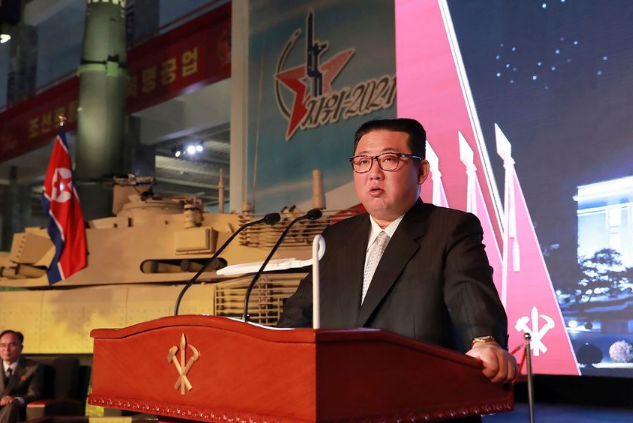North Korea has the capacity to make more base ingredients for nuclear bombs than previously believed, according to new research, suggesting the Kim Jong Un regime possesses the potential to accelerate the earliest stages of production.
The nation’s output of uranium—a fissile material for nuclear weapons when enriched—is just a fraction of what could be produced, according to new research from Stanford University’s Center for International Security and Cooperation.
The assertion is based on satellite-imagery analysis of the equipment and facility size of the Kim regime’s only confirmed operational uranium mining complex in Pyongsan county, about 30 miles north of the Korean Demilitarized Zone. That milling capacity assessment was contrasted with North Korea’s estimated production, based on the levels of waste deposited near the mill.
Furthermore, researchers tracked deforestation levels to study mining activity from 2017 to 2020, using an algorithm to analyze satellite imagery and detect land-use changes.
The gap between potential and actual production may indicate that the Kim regime is satisfied with its current proliferation levels, doesn’t have enough ore to mine or that potential bottlenecks exist at later stages of weapons-grade fissile development, said Sulgiye Park, the report’s lead author who is a nuclear-security research fellow at Stanford.
“It’s using 1/10th or 1/20th of the capacity it has,” Ms. Park said. “The big question is why.”
Though denuclearization talks have stalled in recent years, North Korea hasn’t halted its weapons development. It test-launched a range of shorter-range missiles in recent weeks and is pushing forward on fissile-material production.
North Korean leader Mr. Kim has vowed recently to keep pursuing weapons advances to face the threat from the U.S. and South Korea—accusing both countries of having adopted hostile policies.
Uranium can be found around the world and typically gets used as the fuel for nuclear power plants. But when enriched to a weapons grade of roughly 90% purity, uranium can be used in atomic weapons to set off a chain reaction that creates a nuclear explosion.
At Pyongsan, ore gets crushed, sorted and processed, before the uranium gets extracted, purified and dried into yellowcake that gets transported elsewhere for further enrichment, according to the Stanford report. Uranium can also be used in reactors to make plutonium.
Decades-old estimates of North Korea’s annual uranium ore output were put at roughly 30,000 metric tons, the report said. But the capacity could be as much as 360,000 metric tons, according to the Stanford analysis, which factored in Pyongsan’s milling infrastructure, size and equipment. The estimate assumes optimal operations for 300 days a year.
To assess Pyongsan’s ore quality, Ms. Park, a trained geologist, collected samples from South Korea, as well as rock analysis of other places with similar geological formations.
The findings suggest the Kim regime could process enough yellowcake for up to 340 kilograms of highly enriched uranium a year—enough for more than 20 nuclear bombs annually. In a 2020 assessment, the U.S. Army said North Korea has the ability to manufacture six new bombs a year.
The Stanford report cited other research that estimates North Korea can enrich the equivalent of roughly six to 10 nuclear bombs a year. That means even if Pyongsan churned out much higher levels of yellowcake, expanding fissile-material production would likely face constraints at the North’s Yongbyon facility, where such enrichment work is believed to be done.
“Pyongsan is your first stop for North Korea’s nuclear program because it has the one identifiable mine that we know of,” said Dave Schmerler, a senior research associate at the James Martin Center for Nonproliferation Studies, who has done satellite-imagery analysis of Pyongsan though was uninvolved in the Stanford report.
Dismantling the Pyongsan uranium concentrate plant should be an essential component of any denuclearization talks between the U.S. and North Korea, according to the Center for Strategic and International Studies, a Washington-based think tank, which has published satellite-imagery reports about the mining facilities.
North Korea hasn’t allowed outside nuclear inspectors into the country for more than a decade. Pyongsan was one of several key sites, including Yongbyon, that International Atomic Energy Agency officials visited in the early 1990s.
The Stanford estimates had limitations by relying on satellite imagery, Ms. Park said. Collecting samples from Pyongsan itself would allow her to study rock cross sections to better determine ore quality. Spot checks could provide greater confidence that changes to Pyongsan’s topography arose from mining and not something else.
The U.N.’s atomic agency, in a report submitted in August, said North Korea had appeared to have resumed operation of its plutonium-producing reactor at its Yongbyon facility. The reactor had been inactive since December 2018 until the beginning of July 2021. A nearby laboratory that separates plutonium from spent fuel had also shown signs of being operational around that time.
The mining activities continued at Pyongsan, even last year when North Korea became one of the first countries in the world to seal off its borders as neighboring China began reporting widespread Covid-19 infections.
The Stanford analysis, in contrast with prior reports that focused more on bursts of activity than geological science, tracked deforestation and land-use developments by using algorithms developed by Orbital Insight Inc., whose software can automatically detect such changes. Normally such analysis can take hours to fully characterize what is in a single image, though the algorithms reduced that process to just seconds, said Olivia Koski, an Orbital Insight employee involved in the Stanford research.
In future research using Orbital’s imagery detection tools, an analysis of railcar activity from Pyongsan to North Korea’s Yongbyon facility could offer even more precise measurements on how much yellowcake the country is producing, Ms. Park said. Railway and milling activity was detected as recently as late last month at Pyongsan, she added.
“The activity at this site never really slowed down during Covid,” she said.








































admin in: How the Muslim Brotherhood betrayed Saudi Arabia?
Great article with insight ...
https://www.viagrapascherfr.com/achat-sildenafil-pfizer-tarif/ in: Cross-region cooperation between anti-terrorism agencies needed
Hello there, just became aware of your blog through Google, and found ...